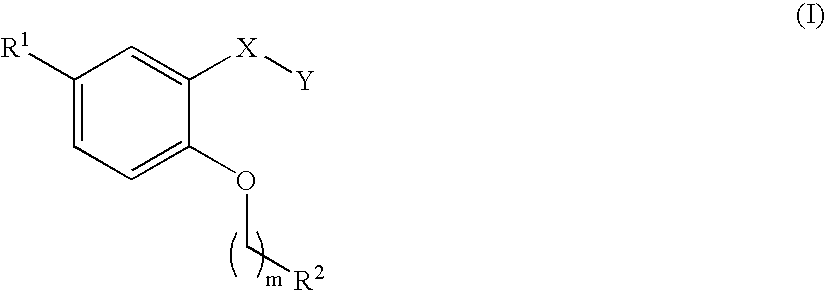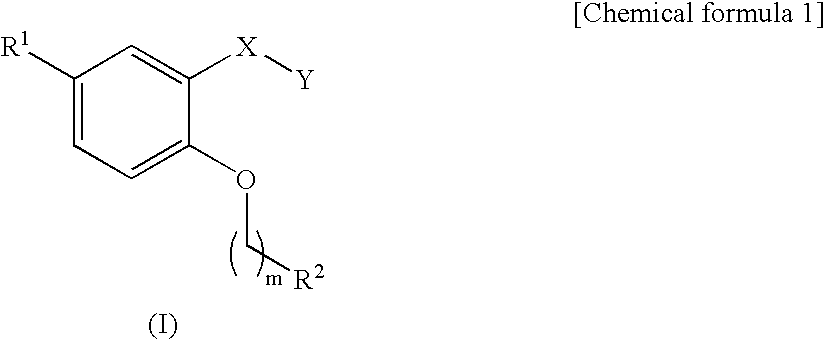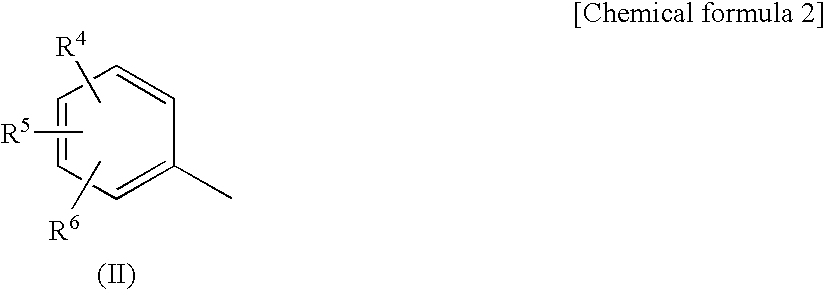Carboxilic acid derivatives
- Summary
- Abstract
- Description
- Claims
- Application Information
AI Technical Summary
Benefits of technology
Problems solved by technology
Method used
Image
Examples
example 1
Preparation of [4-benzyloxy-4′-(trifluoromethoxy)biphenyl 3-yl]acetic acid (compound No. 1)
(1) Preparation of 2-benzyloxy-5-bromophenylacetic acid
[0186]A mixture of 2-benzyloxyphenylacetic acid (242 mg, 11.0 mmol), N-bromosuccinimide (178 mg, 1.9 mmol) and dichloromethane (4 ml) was stirred overnight at room temperature under argon atmosphere. The reaction mixture was diluted with ethyl acetate, washed with saturated brine, and dried over anhydrous sodium sulfate. The solvent was evaporated to give the title compound (280 mg, 87.2%) as a white solid.
[0187]1H-NMR (CDCl3) δ: 3.67 (2H, s), 5.04 (2H, s), 6.78 (1H, d, J=9.6 Hz), 7.25-7.37 (7H, m).
(2) Preparation of [4-benzyloxy-4′-(trifluoromethoxy)biphenyl-3-yl]acetic acid (compound No. 1)
[0188]A mixture of 2-benzyloxy-5-bromophenylacetic acid (261 mg, 0.813 mmol), 4-(trifluoromethoxy)phenyl boronic acid (218 mg, 1.056 mmol), [1,1′-bis(diphenylphosphino)ferrocene]dichloropalladium(II) (43 mg, 0.057 mmol), potassium carbonate (169 mg, 1....
example 2
Preparation of (E)-3-[4-benzyloxy-4′-(trifluoromethoxy)biphenyl-3-yl]propenoic acid (compound No 2)
(1) Preparation of 2-benzyloxy-5-bromobenzaldehyde
[0190]A mixture of benzyl bromide (2.04 g, 11.926 mmol), 5-bromosalicylaldehyde (1.844 g, 9.174 mmol), potassium carbonate (5.07 g, 36.696 mmol) and dimethylformamide (15 ml) was stirred at 50° C. for 2 hours under argon atmosphere. The reaction mixture was cooled to room temperature, diluted with water, and extracted with ethyl acetate. The organic layer was washed with water and saturated brine, and dried over anhydrous sodium sulfate. The residue obtained by evaporation of the solvent under reduced pressure was washed with methanol to give the title compound (1.2 g, 44.9%) as a white solid.
[0191]1H-NMR (CDCl3) δ: 5.10 (2H, s), 6.80 (1H, d, J=9.0 Hz), 7.28-7.44 (6H, m), 7.69 (1H, d, J=2.4 Hz), 10.46 (1H, s).
(2) Preparation of 4-benzyloxy-4′-(trifluoromethoxy)biphenyl-3-carbaldehyde
[0192]The title compound was obtained in the same mann...
example 3
Preparation of 3-[4-benzyloxy-4′-(trifluoromethoxy)biphenyl-3-yl]propanoic acid (compound No. 3)
[0198]A mixture of (E)-3-[4-benzyloxy-4′-(trifluoromethoxy)biphenyl-3-yl]propenoic acid (compound No. 2; 100 mg, 0.241 mmol), platinum oxide (5 mg) and ethanol (10 ml) was stirred for 1 hour under hydrogen atmosphere. The reaction mixture was filtered through celite. The residue obtained by concentration of the filtrate under reduced pressure was washed with methanol under suspension to give the title compound (78 mg, 78.0%) as a white solid.
[0199]1H-NMR (CDCl3) δ: 2.74 (2H, t, J=7.5 Hz), 3.06 (2H, t, J=7.8 Hz), 5.14 (2H, s), 6.96 (2H, d, J=8.4 Hz), 7.22-7.54 (11H, m).
PUM
| Property | Measurement | Unit |
|---|---|---|
| Molar density | aaaaa | aaaaa |
| Molar density | aaaaa | aaaaa |
| Molar density | aaaaa | aaaaa |
Abstract
Description
Claims
Application Information
 Login to View More
Login to View More - R&D
- Intellectual Property
- Life Sciences
- Materials
- Tech Scout
- Unparalleled Data Quality
- Higher Quality Content
- 60% Fewer Hallucinations
Browse by: Latest US Patents, China's latest patents, Technical Efficacy Thesaurus, Application Domain, Technology Topic, Popular Technical Reports.
© 2025 PatSnap. All rights reserved.Legal|Privacy policy|Modern Slavery Act Transparency Statement|Sitemap|About US| Contact US: help@patsnap.com



